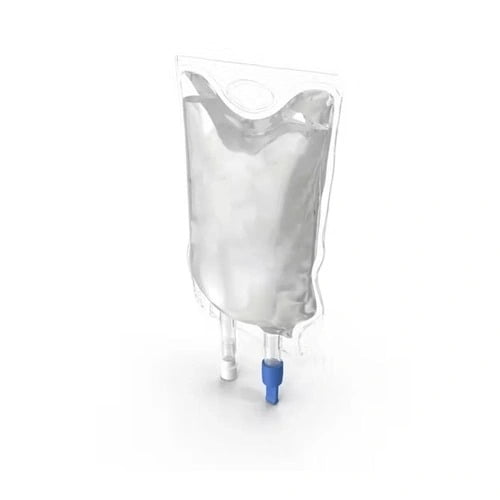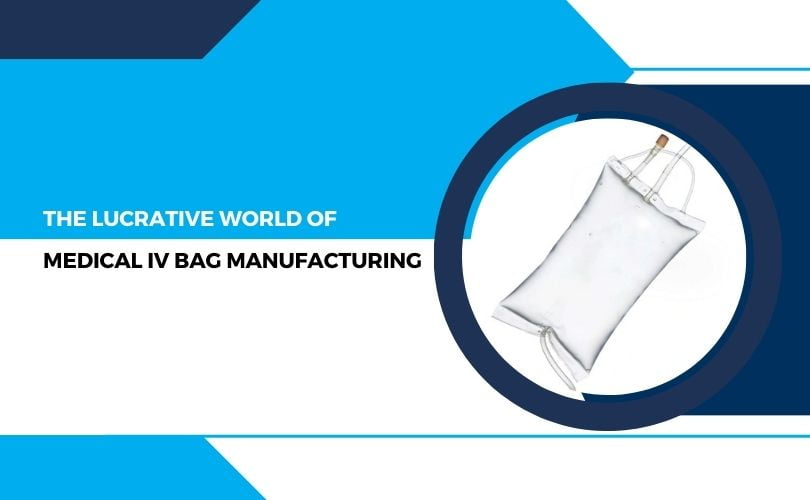Medical IV bags have quietly become a cornerstone of modern healthcare. These unassuming bags play a pivotal role in delivering life-saving fluids and medications directly into a patient’s bloodstream. In this blog post, we’ll delve into the thriving industry of medical IV bag manufacturing, exploring the intricate processes, market dynamics, and the critical importance of these unassuming lifesavers.
Table of Contents
Introduction
Medical IV bags, often taken for granted, hold immense significance in modern healthcare. These unassuming bags play a vital role in the treatment and care of patients. Their primary purpose is to deliver fluids, medications, and nutrients directly into a patient’s bloodstream, making them indispensable in various medical scenarios. IV bags ensure precise dosage administration, maintain hydration levels, and provide essential nutrients, especially in critical situations such as surgery, chemotherapy, or severe dehydration. The sterility and reliability of these bags are paramount, as contamination can lead to severe infections and complications.
Understanding Medical IV Bags
Medical IV’s or intravenous bags are fundamental components of modern healthcare. These unassuming yet crucial devices are designed to deliver life-saving fluids, medications, and nutrients directly into a patient’s bloodstream. To comprehend their significance, it’s essential to delve into the key aspects of medical IV bags:

- Definition and Purpose: Medical IV bags are sterile containers typically made from materials like PVC (polyvinyl chloride) or polyethylene. They come in various sizes, from small volumes for pediatric patients to larger bags for adult treatments. Their primary purpose is to facilitate intravenous therapy, ensuring essential substances’ safe and precise administration.
- Materials Used: IV bags are predominantly constructed from plastic materials due to their durability, flexibility, and compatibility with medical use. These materials are chosen for their ability to withstand the rigors of the manufacturing process while maintaining sterility.
- Various Sizes and Applications: The versatility of medical IV bags lies in their range of sizes, accommodating different fluid volumes. This adaptability allows healthcare providers to tailor treatment plans to each patient’s unique needs. Small bags may be suitable for quick infusions, while larger bags are used for extended therapies or hydration.
- Emphasis on Sterility: Sterility is a paramount concern in IV bag manufacturing. Contaminated IV bags can lead to severe infections and complications for patients. Therefore, manufacturers implement rigorous quality control measures to maintain a sterile production environment, from raw materials to the finished product.
Medical IV bags serve as a lifeline in healthcare, enabling precise and controlled treatment delivery. Their role extends beyond the simple appearance of plastic bags, as they are vital tools that healthcare professionals rely on to provide optimal patient care.
What Are Medical IV Bags?
Medical IV bags, or intravenous bags, are sterile containers designed for a singular purpose – to deliver essential fluids, medications, and nutrients intravenously. Crafted from top-notch plastics like PVC or polyethylene, these bags come in various sizes to cater to different fluid volumes, ensuring precise treatment.
The Vital Role of Sterility
Sterility is paramount in IV bag manufacturing. The consequences of contamination are dire, leading to severe infections and complications. Manufacturers adhere to stringent quality control measures to maintain pristine conditions throughout production.
The Manufacturing Process of Medical IV Bags
The production of medical IV bags is a complex and highly regulated process that involves several critical stages to ensure the safety and effectiveness of these lifesaving medical devices. Let’s take a closer look at the manufacturing process:
Raw Material Selection
The journey begins with carefully selecting high-quality plastic materials, such as PVC (polyvinyl chloride) or polyethylene. These materials are chosen for their durability, flexibility, and biocompatibility.
Extrusion and Blowing
Once the raw materials are selected, they undergo extrusion and blowing. The plastic is heated and then shaped into the desired bag form by extrusion. This process ensures uniform thickness and strength. Specialized machinery is used to achieve precision.
Sterilization
Sterility is of utmost importance in IV infusion bag manufacturing. After the bags are formed, they go through a rigorous sterilization process. This step is essential to eliminating potential contaminants and ensuring the bags are safe for medical use. Common methods of sterilization include gamma irradiation or ethylene oxide gas.
Filling and Sealing
The next critical step is filling the IV bags with the prescribed fluids, medications, or nutrients. This process is carried out in a controlled and sterile environment to prevent contamination. The precise measurement of the substances being delivered is crucial to patient safety. After filling, the bags are sealed securely to maintain sterility.
Quality Control
Quality control checks are performed at various stages of production to verify the integrity of the IV bags. These checks include ensuring that the bags meet thickness, strength, and sterility specifications. Any defective bags are discarded to ensure that only the highest quality products reach healthcare facilities.
The manufacturing process of medical IV bags requires precision, attention to detail, and a commitment to maintaining sterile conditions throughout. Every step is carefully monitored to ensure the final product is safe and reliable for use in patient care. These meticulous manufacturing processes are essential to guarantee the well-being of patients who depend on IV bags for critical medical treatments.
Market Trends and Growth in Medical IV Bag Manufacturing
The world of medical IV bag manufacturing is essential and dynamic, with several notable market trends and robust growth. Understanding these trends is crucial for Siny Medical Banana IV Bag manufacturers and healthcare stakeholders. Here’s a closer look at the current market dynamics:

Increasing Demand
The demand for medical IV bags is on a continuous upward trajectory. Several factors contribute to this growing need:
- Aging Population: As the global population ages, a heightened demand for medical treatments often requires intravenous therapies. Elderly individuals are more likely to require hydration and medication administered via IV bags.
- Prevalence of Chronic Illnesses: The prevalence of chronic diseases, such as diabetes and cancer, necessitates ongoing medical treatments that frequently involve the use of IV bags for drug delivery.
- Advancements in Medical Treatments: Advances in medical science have led to new therapies and treatments that rely on intravenous delivery, further fueling demand.
Technological Advancements
Manufacturers are continually innovating to meet the evolving needs of the healthcare industry:
- Specialized IV Bags: Tailored IV bags designed to accommodate specific medications and therapies are becoming more common. These specialized bags ensure precise delivery of treatments.
- Eco-Friendly Options: With a growing emphasis on environmental sustainability, manufacturers are developing eco-friendly IV bag alternatives to reduce plastic waste and minimize the industry’s ecological footprint.
These trends demonstrate the adaptability of the medical IV bag manufacturing industry, which remains at the forefront of healthcare. The ability to meet the demands of a changing healthcare landscape, coupled with a commitment to innovation and quality, ensures this essential sector’s sustained growth and relevance. As technology advances, we can anticipate further advancements in IV bag design and production, ultimately benefiting patient care and safety.
The Crucial Role of IV Bags in Patient Care
Medical IV bags, often seen as unassuming tools in healthcare, play a pivotal and irreplaceable role in patient care. Their significance transcends their simple appearance; they are lifelines in various medical scenarios. Let’s delve into the indispensable role of IV bags in patient care:
Precision Dosage Administration
IV bags enable healthcare providers to administer medications with unparalleled precision. Medications delivered intravenously enter the bloodstream directly, allowing for rapid and controlled distribution. This precision is crucial when even slight dosage variations can profoundly affect patient outcomes.
Hydration Maintenance
In cases of severe dehydration, such as due to illness or surgery, IV bags provide a reliable and immediate means of rehydration. Proper hydration is essential for the body’s functions and the recovery process. IV bags offer a controlled way to replenish fluids efficiently.
Nutrient Delivery
IV bags are a lifeline for patients who cannot consume food or require specialized nutrients. They can deliver vital nutrients directly into the bloodstream, ensuring that patients receive the necessary sustenance when their digestive systems may be compromised.
Critical Care Scenarios
In critical care settings, such as intensive care units (ICUs) or emergency rooms, IV bags are often the first line of treatment. They allow healthcare professionals to respond swiftly to life-threatening conditions, delivering medications and fluids to stabilize patients.
Chemotherapy and Long-Term Therapies
IV bags are integral to chemotherapy and long-term therapies. Cancer patients undergoing chemotherapy rely on IV bags for the controlled administration of potent medications. Similarly, individuals with chronic illnesses may require ongoing therapies delivered via IV.
Surgical Procedures
Surgeries often require patients to be under anesthesia and unable to consume food or water. IV bags ensure patients remain hydrated and receive necessary medications during and after surgery, contributing to successful recovery.
Medical IV bags are unsung heroes in healthcare. They provide a means to deliver essential treatments, fluids, and nutrients precisely and promptly. Their reliability and sterility are paramount, impacting patient safety and well-being. While they may appear as simple plastic bags, their role in patient care is extraordinary, making them an essential component of modern medicine.
Conclusion
The world of medical IV bag manufacturing is indeed a lucrative and vital component of modern healthcare. These unassuming yet essential devices deliver lifesaving fluids, medications, and nutrients directly into a patient’s bloodstream. As we conclude our exploration of this industry, it’s evident that several key factors contribute to its significance.
The stringent manufacturing processes, from raw material selection to sterilization and quality control, ensure that IV bags meet the highest safety and reliability standards. Sterility is paramount, as any contamination can have severe consequences for patients.
In inpatient care, IV bags serve as lifelines. They enable precise dosage administration, maintain hydration levels, and provide vital nutrients, particularly in critical scenarios such as surgeries, chemotherapy, and severe dehydration.
The lucrative medical IV bag manufacturing world is a testament to the importance of innovation and quality in healthcare. As technology advances, we expect even more specialized and eco-friendly IV bag solutions to emerge, further improving patient care and safety. When in the hands of skilled healthcare professionals, these seemingly simple plastic bags become instruments of healing and hope, ensuring that patients receive the precise treatments they need for a healthier future.
FAQs (Frequently Asked Questions)
Are medical IV bags recyclable?
Yes, medical IV bags are typically made from recyclable plastic materials. However, ensuring they are properly cleaned and sorted before recycling is essential to maintaining safety and hygiene standards.
How are IV bags sterilized?
IV bags undergo sterilization through various methods, such as gamma irradiation or ethylene oxide gas. These processes are carefully controlled to eliminate any potential contaminants and maintain sterility.
What are the environmental concerns associated with IV bag production?
While IV bags are crucial in healthcare, there is a growing concern about the environmental impact of plastic waste. To address this, manufacturers are developing eco-friendly IV bag alternatives to reduce plastic waste and minimize their ecological footprint.
Can IV bags be customized for specific medications?
Manufacturers can produce specialized IV bags designed to accommodate specific medications and therapies. These customized bags ensure the precise delivery of treatments tailored to individual patient needs.
What is the shelf life of medical IV bags?
The shelf life of medical IV bags can vary depending on the materials used and storage conditions. Typically, these bags have a shelf life of 2 to 3 years when stored in a cool, dry place. It’s essential for healthcare facilities to regularly check expiration dates to ensure the safety and effectiveness of IV bags.



























































